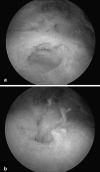Calcific tendinitis of the rotator cuff: state of the art in diagnosis and treatment
- PMID: 26163832
- PMCID: PMC4805635
- DOI: 10.1007/s10195-015-0367-6
Calcific tendinitis of the rotator cuff: state of the art in diagnosis and treatment
Abstract
Calcific tendinitis is a painful shoulder disorder characterised by either single or multiple deposits in the rotator cuff tendon. Although the disease subsides spontaneously in most cases, a subpopulation of patients continue to complain of pain and shoulder dysfunction and the deposits do not show any signs of resolution. Although several treatment options have been proposed, clinical results are controversial and often the indication for a given therapy remains a matter of clinician choice. Herein, we report on the current state of the art in the pathogenesis, diagnosis and treatment of calcific tendinitis of the rotator cuff.
Keywords: Calcific tendinitis; Diagnosis; Rotator cuff; Shoulder; Treatment options.
Figures



References
-
- Bosworth BM. Calcium deposits in the shoulder and subacromial bursitis: a survey of 12122 shoulders. JAMA. 1941;116:2477–2482. doi: 10.1001/jama.1941.02820220019004. - DOI
-
- Codman EA. The shoulder. Boston: Thomas Todd; 1934.
-
- Bosworth BM. Examination of the shoulder for calcium deposits. Technique of fluoroscopy and spot film roentgenography. J Bone Jt Surg. 1941;23:567–577.
-
- Welfling J, Kahn MF, Desroy M, Paolaggi JB, de Sèze S. Calcifications of the shoulder. II. The disease of multiple tendinous calcifications. Rev Rhum Mal Osteoartic. 1965;32(6):325–334. - PubMed
Publication types
MeSH terms
LinkOut - more resources
Full Text Sources
Other Literature Sources
Medical

